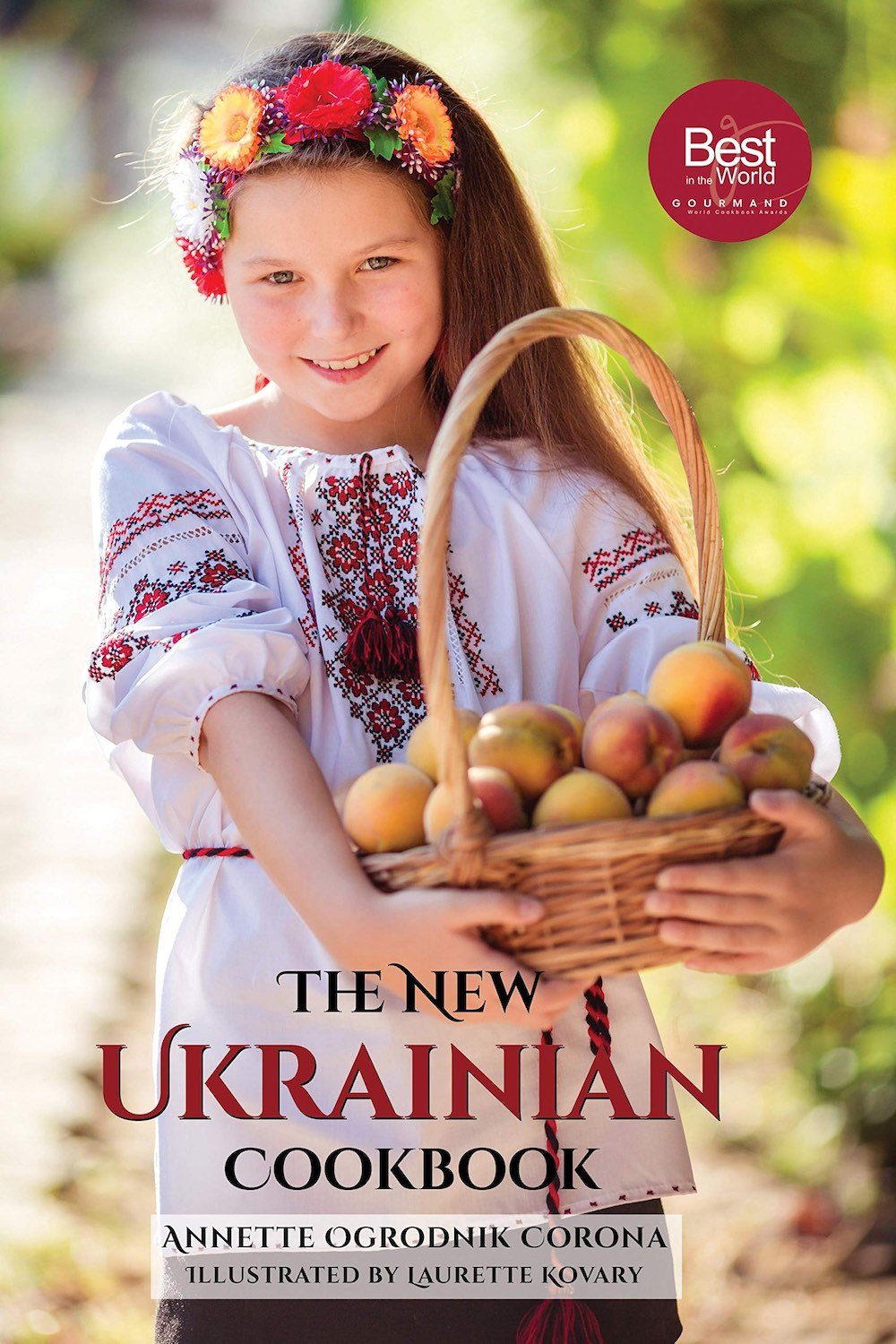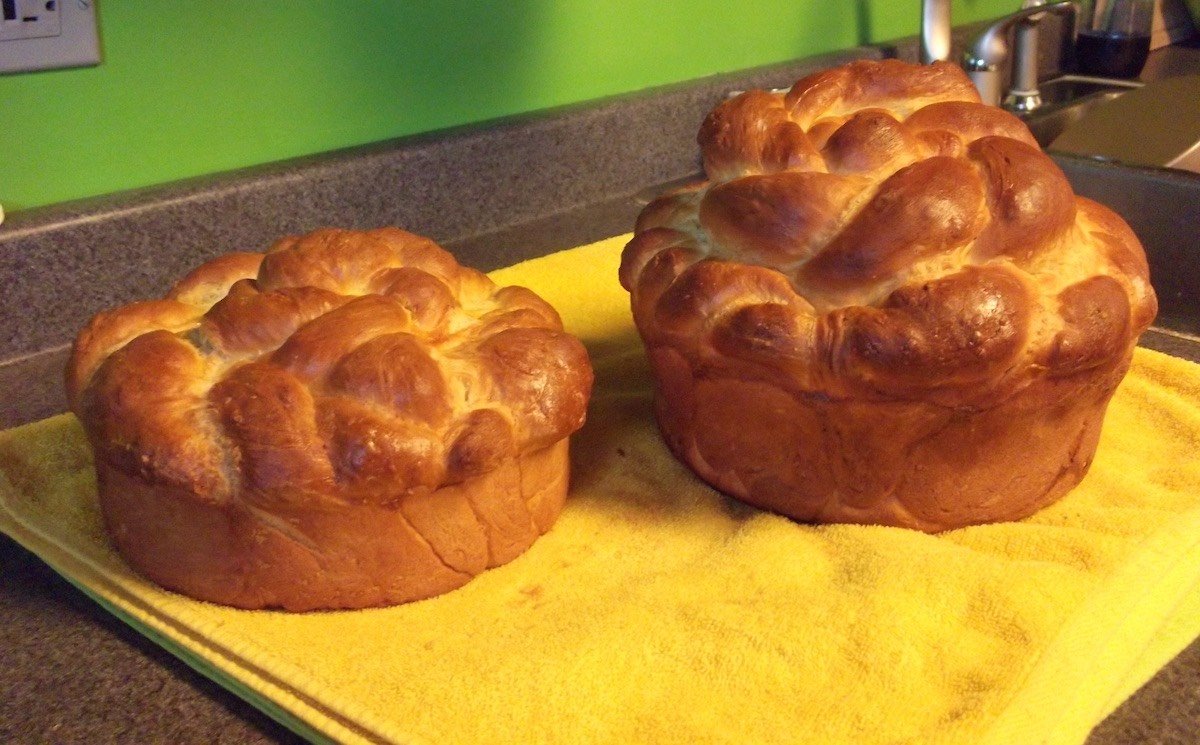Advertisement
Behind the Cookbook: The New Ukrainian Cookbook
5 April 2022 · Behind the Cookbook
Food writer, blogger, cooking instructor, local-food advocate… Bethlehem, Pennsylvania-based Annette Ogrodnik Corona has many strings to her bow. She is also the author of the enchanting The New Ukrainian Cookbook, a recent arrival on ckbk.
Pennsylvania has a sizeable Ukrainian-American diaspora community, of which the author is a part. Her Baba (grandmother) emigrated from the Ternopil region of north-western Ukraine in 1909 and settled in the Lehigh Valley countryside, where the family ran a 54-acre farm, carrying on many of the traditions of the ‘old country’ – particularly as far as food was concerned.
“Baba’s kitchen was not only beautiful, it had a soul… Her kitchen welcomed everyone – not only other Ukrainians. She had a reputation for great culinary prowess and convivial hospitality, so her kitchen was often a gathering place for the hungry and weary, and definitely for those who were in search of a memorable meal.”
The book weaves together the history of Ukraine (including the country’s culinary history), its folklore, and her family’s traditions, with recipes and beautiful illustrations.
The 238 recipes in the book include a whole chapter on borshch and soups, plus dumplings, noodles and griddlecakes, meat and poultry, breads, buns, and rolls. If you’re one of the many cooks supporting #CookForUkraine through a bake sale or other fundraiser, the recipes in this book offer a wealth of choices for your menu, including some special Easter dishes.
Here Annette tells us about Ukraine’s Easter traditions and shares a few tips on how to create a big, beautiful loaf of her special Paska bread to share with family and friends.
Easter traditions in Ukraine
Traditions that originated in pre-Christian times in Ukraine echoed the religious dogma, social structure, and agrarian way of life of its people. So often helpless in the face of nature’s power, their ‘religious’ practices evolved into various cults that worshipped natural phenomena such as the stars, sun, moon, wind, fire, and water. There were also cults of trees and animal cults. Through taking part in ritual dances, incantations, and special offerings, people sought to appease nature.
Spring is the most important time of year in an agrarian society, and it was greeted by the baking of special breads, the coloring of eggs (standing for the renewal of life itself), and by decorating of pysanky (symbolic batik-ornamented eggs, which were not meant to be eaten). One example of special springtime breads is associated with birds. A first sign of spring is the arrival of migrating birds, so breads in the shape of birds were baked and given to children, who ran through the fields tossing them in the air while singing traditional songs and prescribed sayings.
With the coming of Christianity, the Church merged several of these agrarian seasonal activities and spring holiday traditions with Easter, and to this day they continue to be a part of Ukrainian Eastertime celebrations.
Ukrainian Easter and the Easter basket
Preparations for Easter start weeks in advance, and many observe Lent and fast, as Easter feasts often consist of some of the richest foods imaginable. It is almost as if the Ukrainian people are making up for all the foods abandoned during Lent!
The Easter basket contains:
Paska Bread – The traditional Easter bread, a small loaf will do.
White or beeswax candle – To be placed in the center of the Paska bread; it will be lit during the ceremony.
Babka – A small plain or decorated loaf will do.
Pysanky – Inedible batik-decorated Easter eggs (new ones are acquired every year).
Krashanky – Dyed hard-cooked eggs; a variety of single-colored eggs is acceptable, but one must be red, as it is the color that symbolizes the sun. Peeled, hard-cooked eggs.
Salt – Just a small amount is appropriate.
Butter – Softened butter is artfully shaped with one’s hands and is placed in a small dish or presented in a mold. Some decorate the butter with whole cloves in the shape of a cross.
Cheese Paska – Place a small amount of this ‘sweet cheese’ on the plate next to the butter.
Horseradish – A piece of horseradish root is acceptable or a small dish of beet and horseradish relish.
Kovbasa – A piece or small ring of smoked Ukrainian sausage.
Ham – A wedge or small ham.
The basket itself should be lined with a newly embroidered white runner and an embroidered servetka or runner should be used to cover the basket. Tie a few pussy willows to the handle of the basket (in pre-Christian times the willow tree was thought to have medicinal and magical powers). Periwinkle and a few fresh spring flowers may be added, and make sure there is a red ribbon – to ward off evil! Remember, tradition dictates that the mistress of the house will be judged according to the way her Easter basket looks, how it is decorated, and what it contains.
From Preparing the Pride and Joy of the Family – The Easter Basket.
Learn more about the Ukrainian Easter Basket tradition in this documentary by Elisabeth Luard
The breadbasket of Europe
Ukraine’s reputation as ‘the breadbasket of Europe’ is evident in the number of bread recipes. In my cookbook, I offer a mere drop in the ocean of recipes that make up Ukraine’s baking repertoire. Here is my recipe for Easter Paska Bread — it is not difficult to make.
Paska bread is baked especially the blessing of foods at church on Easter morning. Much richer than ordinary bread, it is flavored with plenty of eggs and melted butter. Many a paska bread is decorated with dough ornaments such as rosettes, swirls, and twists. I like to decorate mine with crosses and swirls and I often keep one piece of dough to make paska doves (as described in the recipe), which I bake separately.
One may find it unusual that I use a Dutch oven pot to make my bread, but I use it because that is what my Baba (grandmother) used and almost everyone has one in their home kitchen. Try it. I assure you the end result will yield a big, beautiful loaf of bread – a work of art that will wow family and friends!
Borshch
“Borshch: The center of everything” — Ukrainian proverb
Borshch is the quintessential soup of Ukraine. Probably more than any other traditional dish, it reflects the Ukrainian character and, to some extent, Ukrainian ethnic history. To a great many Ukrainians living in Ukraine, borshch continues to be their staple food, the principal dish on their daily menu.
Borshch is thought to have originated back in the 14th century and is commonly known in the West as red beet soup. There are as many variations of this soup as there are cooks in Ukraine! However, despite all the variations, the common denominator in all borshch is the presence of the luscious red beet, in one form or another, which gives the soup its characteristic crimson color and distinctive flavor.
Borshch may be served hot or cold, clear, or with many vegetables and meat. Smetana, or sour cream, is the chief of all accompaniments and is always swirled into each bowl tableside, adding a finishing flavor all its own. If one observes Lent, the borshch will be meatless during that season and the only accompaniment may be a sprinkling of freshly chopped dill. One thing is for certain though – you should always make plenty of borshch because it tastes better the next day and even better the day after that.
Borshch geography
Varieties of borshch reflect specific geographical areas in Ukraine. For instance, Ukrainians in the western part of the country like the predominance of red beets, while those in the central region like a good amount of cabbage with the beets. It would not be unusual to find grated eggplant, beans, apples, bell peppers, tomatoes, and carrots in addition to the beets and cabbage in the southern regions. Still others add potatoes, insisting it gives the final product a more velvety consistency.
In the southern region around the city of Odesa, among the ingredients one may find in borshch are duck, chicken, and even fish and shellfish. Taking yet another geographical jump, in the river-sliced woodsy region of Polissya, wild mushrooms come to the borshch forefront. Further west in the romantic Carpathian Mountains, mushrooms and beans take center stage in the list of ingredients, and in the villages even higher up in the mountains, beans take precedent.
And lastly, there is even a green borshch made with lemony sorrel leaves or nettles that grow wild in the countryside and are enjoyed by all in the springtime.
Many Ukrainians serve this borshch in spring when the winter beets are over and the young beets are too small to be cooked. This soup features sorrel, or as it is sometimes called sour leaf, a hardy perennial. Sorrel has a sharp, lemony flavor and is said to have a cleansing effect on the body.
More recipes from The New Ukrainian Cookbook
About the author
Annette Ogrodnik Corona is an award-winning cookbook author, freelance food writer, food blogger, and cooking instructor. She has appeared on several cable cooking shows throughout the Philadelphia and Lehigh Valley areas over the last 10 years. She spends her time these days advocating for local food, farmers and sustainable farming practices. She lives with her husband, Kevin, and three Jack Russell terriers, in a house with a tiny kitchen in Bethlehem, Pennsylvania.
More features from ckbk
Find out five things you probably didn’t know about this classic sweet Easter bun.
Zusa Zak introduces her book on the cooking of the Baltic countries.
Sign up for ckbk's weekly email newsletter
Advertisement









